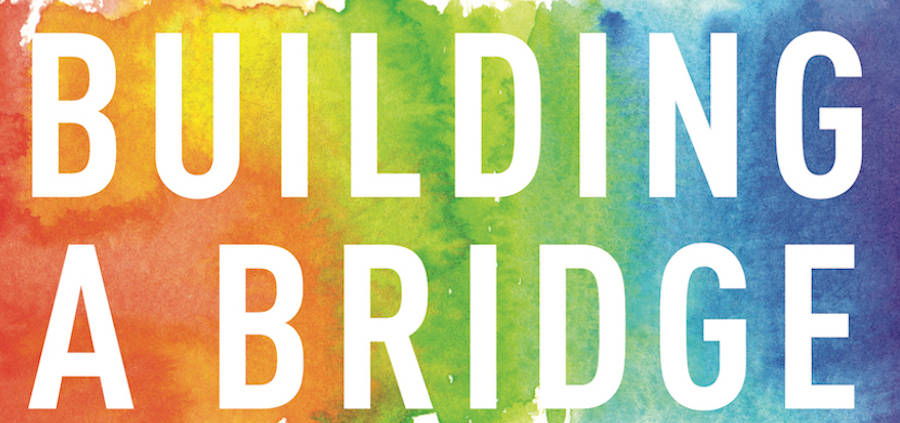Compassion and Connection by Chris Byrd
Building a Bridge
Directed and produced
by Evan Mascagni and Shannon Post
Obscured Pictures
Not Rated 1 hour, 35 minutes
Building a Bridge takes the cinematic partnership between storied Catholic director Martin Scorsese and Jesuit priest James Martin to a new level. Martin was a consultant on the filmmaker’s uneven 2016 adaptation of Japanese novelist Shusaku Endo’s 1966 novel Silence. The Jesuit had a cameo in the film as a priest performing baptisms, and also in Scorsese’s 2019 Netflix epic The Irishman.
Returning these favors, Scorsese executive produces Building a Bridge, which highlights the priest’s important yet controversial attempts to foster greater “respect, compassion and sensitivity” between LGBTQ Catholics and the church hierarchy.
Having debuted at the 2021 Tribeca Film Festival as a welcome companion to Martin’s eponymous 2017 book, the documentary has its television premiere Tuesday June 21 on AMC+. It will also air on Sundance TV on Sunday June 26 at 10 p.m. EST. Evan Mascagni, a Catholic, and Shannon Post, a queer filmmaker, co-direct and produce.
For Martin, America magazine’s editor-at-large and the author of 14 books including Jesus: A Pilgrimage, June 12, 2016, was a turning point. That evening at Orlando’s Pulse nightclub, which catered to the LGBTQ community, 29-year-old Omar Mateen shot and killed 49 patrons and wounded 53 others. It is the worst incident of anti-gay violence and the second-worst mass shooting in US history.
Martin appreciated the statements some Catholic bishops made in response to the massacre, but the majority of the hierarchy’s silence disheartened him. “Even in death,” he says, “these people were largely invisible to the church.” The bishops’ failure to speak out “galvanized” Martin to write the book, which became the basis of his outreach to LGBTQ Catholics.
Mascagni and Post largely adopt a cinéma vérité style as they follow their subject throughout 2019. We travel with him to book signings, talks, and TV show appearances, accompany him as he meets with family members and LGBTQ ministry groups, and share visits with his mother, Eleanor Spano Martin, and his sister, Carolyn Buscarino.
Members from Out at St. Paul, a parish outreach ministry to the LGBTQ community in Long Branch, New Jersey, challenge Martin to reconsider how he conceives of his two-way bridge between the church and LGBTQ folks as described in the first edition of his book. Because these parishioners hold him accountable, Martin has a change of heart; he realizes that since the church marginalizes these souls, it bears the responsibility to initiate bridge building. The book’s second edition reflects this renewed viewpoint.
Viewers who haven’t read the Jesuit’s controversial book may be surprised to discover that Martin’s approach doesn’t diverge from church doctrine. The priest urges a change in the teaching that says “homosexual acts are intrinsically disordered,” but the key phrase “respect, compassion and sincerity” comes from the Catechism. And Martin affirms the church’s teaching on same-sex marriage.
Yet these views are heretical to Michael Voris and the “Church Militant” movement he leads. A 1983 Notre Dame graduate, Voris acknowledges having had gay relationships when he was younger, but now insists that he has left his “sinful” life behind. Crusading against “the sin” of homosexuality animates him and his followers.
Church Militant members protest wherever Martin speaks and troll him on Twitter. The filmmakers tellingly juxtapose a group of them praying the Hail Mary outside a church while inside Martin counsels Christine Leinonen, the mother of a victim of the Pulse nightclub shooting named Christopher, to pray to Mary. This sad, dismaying moment reminds us that those who profess to belong to the same church don’t often act like it.
Mascagni and Post deserve credit for not demonizing Voris. The fair amount of time they spend with him reveals some sympathetic tidbits, such as the “horrible cross” of his mother’s bipolar disease. Unfortunately, Building a Bridge doesn’t deliver similar insight into the personal history of its subject, so that we might come to know and understand the origin of his vocation even better.
One of the more affable figures in American public life, Martin’s wonderful sense of humor delights throughout the film. Often called a “pansy,” he says that as the gardener of his Jesuit community, he “made sure to plant a lot of pansies.” While outside Vatican square awaiting a papal audience in October 2019, speaking into the camera, he closes the film with this line: “Here comes the sun. Where’s our rainbow?”
As some complain that Martin goes too far, others will wish he would do more to reform church teachings. Nonetheless, viewers of Building a Bridge will ultimately admire this man who declares, “I always want to be close to Jesus. That’s why I’m doing all this.” ♦
Chris Byrd writes from Washington, D.C. His work has appeared in America, Sojourners, and the National Catholic Reporter.





Leave a Reply
Want to join the discussion?Feel free to contribute!